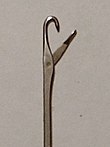Protect (weave)
The shuttle is the central part of a shuttle loom . It contains the long weft thread . The shooter is on the mechanics of the loom by the specialist shot. When the shooter leaves the compartment, the shot is "struck" and the compartment is newly formed; then the shooter is shot back in the opposite direction. This is how the fabric is created.
With a hand loom one speaks of a shuttle or shuttle for short (for heraldic use of the same see shuttle (heraldry) ). It takes its name from its resemblance to a small, flat ship, inside of which the bobbin for the weft thread is attached. On the other hand, the outer shape of the shuttle makes it easier to slide through the shed between the warp threads. This is also the difference between the shuttle and the shooter: While the shuttle should lie comfortably in the hand and experience little force, the shooter is more stable and reinforced at the ends, as it is moved with great force by a shooting device.
In 1733 , John Kay invented the so-called Schnellschützen ("flying shuttle"), which doubled the speed of weaving. The shuttle no longer had to be picked up to shoot thanks to the quick release device and was henceforth called Schützen. However, the yarn of the weft thread was spun manually until well into the 18th century (each weaver had to deliver 4–10 spinners). With the development of the English spinning machine in 1764 , gradually finer yarn could be produced, which also allowed the shuttle to become smaller and the fabric produced finer.
Around 1800, the Power Loom was the first weaving machine that mechanically "shot" the rapid shuttle, sliding horizontally between the warp , through the shed. From 1810 the automatic control of the textile pattern by means of punch cards on dobby and jacquard machines followed. Compared to these machines could craft only claim to about 1,880 with the manual operation of the loom and shuttle.
While the shooter retains his direction only through the threads when passing through the shed in wide looms, in a ribbon loom the shooter is wider than the ribbon and is held to the right or left of the ribbon and moved on by a gear wheel rotating in the guide.
In modern weaving machines , projectiles (which no longer carry a spool of yarn, but rather pull the weft behind them) and grippers are used instead of the shuttle. In modern automatic weaving machines, the weft thread is moved through the shed by air or liquids .
Shooters are still used today, especially with narrow fabrics, as the shot does not have to be cut off on each side of the fabric. Two equally beautiful selvedges are created . With simple and cheaper tape fabrics, however, grippers are increasingly used, with the cut weft thread being crocheted on one edge over a latch needle and fed back a few millimeters into the open compartment in order to fix it.
Other uses
Some older sewing machines used shuttles (swing shuttles) to thread the bobbin thread.
The winding of toroidal transformers and toroidal core throttles also requires boats.
See also
- Spindle (heraldry) , to the shuttle in coat of arms
- Technology in industrialization



